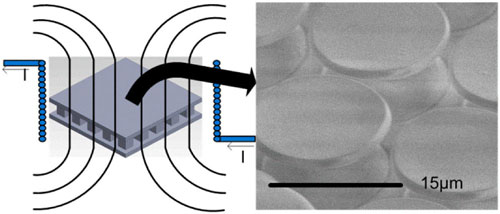| Posted: Jan 28, 2015 |
Dry adhesives controlled by a magnetic field
|
|
(Nanowerk News) Researchers at Simon Fraser University have developed a method of fabricating magnetically controlled dry adhesive devices. As the team reports in the January 15, 2015 online edition of ACS Applied Materials & Interfaces ("Magnetic Field Switchable Dry Adhesives"), a magnetically controlled dry adhesive device is fabricated by dispersing iron oxide particles in a PDMS matrix.
|
 |
| A magnetic field controllable dry adhesive device is manufactured. The normal adhesion force can be increased or decreased depending on the presence of an applied magnetic field. (© ACS)
|
|
Using a coil, a magnetic field of up to 0.0133 ± 0.0009 T was generated and, when normal adhesion pressure measurements were performed, decreased normal adhesion pressures were measured when the applied magnetic field was present during the entire normal dry adhesive test cycle as compared to when there was no applied magnetic field present.
|
|
Similarly, a decrease in adhesion was measured when the magnetic field was present during only the preload portion of the normal adhesion test cycle.
|
|
In both cases, the decrease in adhesion pressure was due to an increase in the overall stiffness of the magnetically controlled dry adhesive device resulting in a smaller contact area with the spherical glass probe under the same preloading force.
|
|
When the magnetic field was present during only the pulloff portion of the dry adhesion test cycle, the measured pulloff pressure increased when the applied magnetic field was in orientation 1 and decreased when the applied magnetic field was in orientation 2.
|
|
With the magnetic field applied in orientation 1 when the device was preloaded, a spike in preloading force, because of the height of the device changing, was seen and was responsible for increasing the contact area which resulted in increased adhesion.
|
|
When the magnetic field in orientation 2 was switched with the device preloaded, a decreasing spike in preload force was observed because of the thickness of the device decreasing, and a slight decrease in adhesion pressure was measured as compared to when no applied magnetic field was present. Multiple devices showed similar adhesion characteristics.
|

